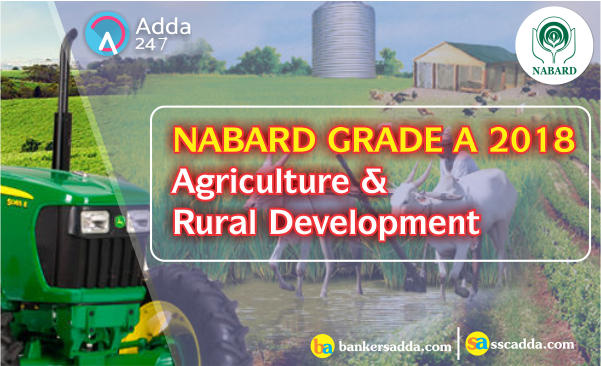
The upcoming important exams are NABARD grade A and grade B, in which there is a section Agriculture & Rural Development (with a focus on Rural India) having high weightage of 40 marks. So, for the same, it becomes really important to have an in-depth knowledge of the various terminologies and practices involved in agriculture. Further its imperative to be aware of the present scenario of Indian Agriculture and the state of Rural Development in India. To help you with this, today, we are providing you with all necessary information related to the mentioned field which will help you to fetch some good marks.
Command Area Development
The Centrally sponsored Command Area Development (CAD) Programme was launched in 1974-75 with the main objectives of improving the utilization of created irrigation potential and optimizing agriculture production and productivity from irrigated agriculture through a multi-disciplinary team under an Area Development Authority.
The Command Area Development Programme is an integrated area development approach towards the command areas of major and medium irrigation projects in the country. The Command Area Development Wing of the Ministry of Water Resources coordinates and monitors the implementation of CADWM at the national level. Proposals received from the States for inclusion of new projects under the programme are examined and, if found techno-economically feasible, are included.
The main objectives covered under the programme are:-
a) Bridge the gap between potential created and their utilization through micro-level infrastructure development and efficient farm water management practices.
b) Optimization of agricultural productivity & production and
c) Improvement in socio-economic conditions of farmers
The Programme includes the following components:-
a) On-Farm Development (OFD) works i.e. Development of field channels and field drains within the command of each outlet; land leveling; reclamation of waterlogged areas (since April 1996); enforcement of a proper system of Warabandi and fair distribution of water to the fields; realignment of field boundaries wherever necessary (if possible, consolidation of holding); supply of all inputs and services including credit; strengthening of extension services; and, encouraging farmers for participatory irrigation management (PIM).
b) Selection and introduction of suitable cropping pattern.
c) Development of groundwater to supplement surface irrigation.
d) Modernization, maintenance and efficient operation of the irrigation system upto the outlet of one-cusec capacity (irrigation sector).
e) Correction of System Deficiencies
f) Desilting of Tanks in CAD Commands for augmenting supplies
g) Bio-Drainage (selective areas).
On-Farm Development Works (OFD)
On-Farm Development works include lining of field irrigation channels and infrastructural facilities like bed regulators, diversion and distribution boxes, turnouts and drop structures to regulate and convey the irrigation water from government controlled outlets to individual land holdings.
This type of work mainly aims to reduce conveyance and application losses, to minimize water logging condition and to conserve water
Rotational Water Supply (RWS)
RWS is one of the techniques is irrigation water distribution management. It aims at equi-distribution of irrigation water irrespective of location of the land in the command area by enforcing irrigation time schedules.
Water Conservation Techniques
Water conservation includes all the policies, strategies and activities to sustainably manage the natural resource of fresh water, to protect the hydrosphere, and to meet the current and future human demand. Population, household size, and growth and affluence all affect how much water is used. Factors such as climate change have increased pressures on natural water resources especially in manufacturing and agricultural irrigation.
a) Conservation by surface water storage: Storage of water by construction of various water reservoirs have been one of the oldest measures of water conservation. The scope of storage varies from region to region depending on water availability and topographic condition.
b) Conservation of rainwater: Contour farming is an example of rain water harvesting technique involving water and moisture control at a very simple level. It often consists of rows of rocks placed along the contour of steps. Runoff captured by these barriers also allows for retention of soil, thereby serving as erosion control measure on gentle slopes. This technique is especially suitable for areas having rainfall of considerable intensity, spread over large part i.e. in Himalayan area, north east states and Andaman and Nicobar Islands
c) Groundwater conservation: It is done by-
(i) Artificial recharge: Water is spread over ground to increase area and length of time for water to remain in contact with soil. So as to allow maximum possible opportunity for water to enter into the ground.
(ii) Percolation tank method: Percolation tanks are constructed across the water course for artificial recharge.
d) Catchment area protection (CAP): Catchment protection plans are usually called watershed protection or management plans.These form are an important measure to conserve and protect the quality of water in a watershed. It helps in withholding runoff water albeit temporarily by a check bund.
e) Inter-basin transfer of water.
f) Adoption of drip sprinkler irrigation: Surface irrigation methods, which are traditionally used in our country, are unsuitable for water scarce areas, as large amount of water is lost through evaporation and percolation. Drip irrigation is an efficient method of irrigation in which a limited area near the plant is irrigated by dripping water.
g) Management of growing pattern of crops: In water scarce areas, the crop selection should be based on efficiency of the crop to utilize the water. Some of the plants suitable for water scarce areas are plants with shorter growth period; High yielding plants that require no increase in water supply; Plants with deep and well trenched roots and Plants which cannot tolerate surface irrigation.
h) Reducing evapotranspiration: Evapotranspiration losses can be reduced by reducing the evaporation from soil surface and transpiration from the plants, in arid zones, considerable amount of water is lost in evaporation from soil surface. This can be prevented by placing water tight moisture barriers or water tight mulches on the soil surface. Non-porous materials like papers, asphalt, plastic foils or metal foils can also be used for preventing evaporation losses.
i) Reducing evaporation from various water bodies: The water losses through evaporation from storage tanks, reservoirs, irrigation tanks, rivers and canals reduce the water available for various uses. The methods that reduce evaporation from water bodies are- installing wind breaks, reducing energy available for evaporation, constructing artificial aquifers, minimizing exposed surface through reservoir regulation, reducing ratio of area/volume of water bodies, locating reservoirs at higher altitudes and applying monomolecular firms.
j) Recycling of water: The wastewater from industrial or domestic sources can be used after proper treatment, for irrigation, recharging ground water, and even for industrial or municipal use. If agricultural lands are available close to cities, municipal waste water can be easily used for irrigation.
Micro-Irrigation
It can be defined as the application of water at low volume and frequent interval under low pressure to plant root zone. Micro-irrigation, also called localised irrigation, low volume irrigation, low-flow irrigation, or trickle irrigation is an irrigation method with lower pressure and flow than a traditional sprinkler system. Low volume irrigation is used in agriculture for row crops, orchards, and vineyards. It is also used in horticulture in wholesale nurseries, in landscaping for civic, commercial, and private landscapes and gardens, and in the science and practice of restoration ecology and environmental remediation.
Micro irrigation is defined as the frequent application of small quantities of water directly above and below the soil surface; usually as discrete drops, continuous drops or tiny streams through emitters placed along a water delivery line.
Need of Micro Irrigation:
a) To make agriculture productive,
b) Environmentally sensitive and capable of preserving the social fabric of rural communities
c) Help produce more from the available land, water and labor resources without either ecological or social harmony,
d) Generate higher farm income
e) On-farm and off-farm employment.
Irrigation Pumps
The mechanical device or arrangement by which water is caused to flow at increased pressure is known as a pump and the process of using a pump for this purpose is known as pumping.
Pumps are classified on the basis of mechanical principles of operation as
a) Positive Displacement Pumps: In a positive displacement pump, the fluid is physically displaced by mechanical devices such as the plunger, piston, gears, cams, screws etc. In this type of pump, a vacuum is created in a chamber by some mechanical means and then water is drawn in this chamber. The volume of water thus drawn in the chamber is then shifted or displaced mechanically out of chamber. These are further classified into :
(i) Reciprocating Pump
(ii) Rotary Pump
b) Variable Displacement Pumps: The distinguishing feature of variable displacement pumps is the inverse relationship between the discharge rate and the pressure head. As the pumping head increases, the rate of pumping decreases. They are also termed as Roto Dynamic Pumps. These are urther classified into:
(i) Centrifugal Pump
(ii) Turbine Pump
(iii) Propeller Pump
(iv) Jet Pump
(v) Air Lift Pump
Major, Medium and Minor Irrigation.
Irrigation projects in Indian context is classified as follows:
a) Major project: This type of project consists of huge surface water, storage reservoirs and flow diversion structures. The area envisaged to be covered under irrigation is of the order over 10000 hectare.
b) Medium project: These are also surface water projects but with medium size storage and diversion structures with the area under irrigation between 10000 hectare and 2000 hectare.
c) Minor project: The area proposed under irrigation for these schemes is below 2000Ha and the source of water is either ground water or from wells or tube wells or surface water lifted by pumps or by gravity flow from tanks. It could also be irrigated from through water from tanks.
The major and medium irrigation projects are further classified as
a) Direct irrigation method
b) Storage irrigation method.
Commanded area (CA): is defined as the area that can be irrigated by a canal system, the CA may further be classified as under:
Gross command area (GCA): This is defined as total area that can be irrigated by a canal system on the perception that unlimited quantity of water is available. It is the total area that may theoretically be served by the irrigation system. But this may include inhibited areas, roads, ponds, uncultivable areas etc which would not be irrigated.
Culturable command area (CCA): This is the actually irrigated area within the GCA. However, the entire CCA is never put under cultivation during any crop season due to the following reasons:
a) The required quantity of water, fertilizer, etc. may not be available to cultivate the entire CCA at a particular point of time. Thus, this is a physical constraint.
b) The land may be kept fallow that is without cultivation for one or more crop seasons to increase the fertility of the soil. This is a cultural decision.
c) Due to high water table in some areas of the CCA irrigated water may not be applied as the crops get enough water from the saturation provide to the surface water table.
During any crop season, only a part of the CCA is put under cultivation and this area is termed as culturable cultivated area. The remaining area which is not cultivated during a crop season is conversely termed as culturable uncultivated area.
Intensity of irrigation is defined as the percentage of the irrigation proposed to be irrigated annually. Usually, the areas irrigated during each crop season (Rabi, Kharif, etc) is expressed as a percentage of the CCA which represents the intensity of irrigation for the crop season. By adding the intensities of irrigation for all crop seasons the yearly intensity of irrigation to be obtained.
You may also like to Read:






